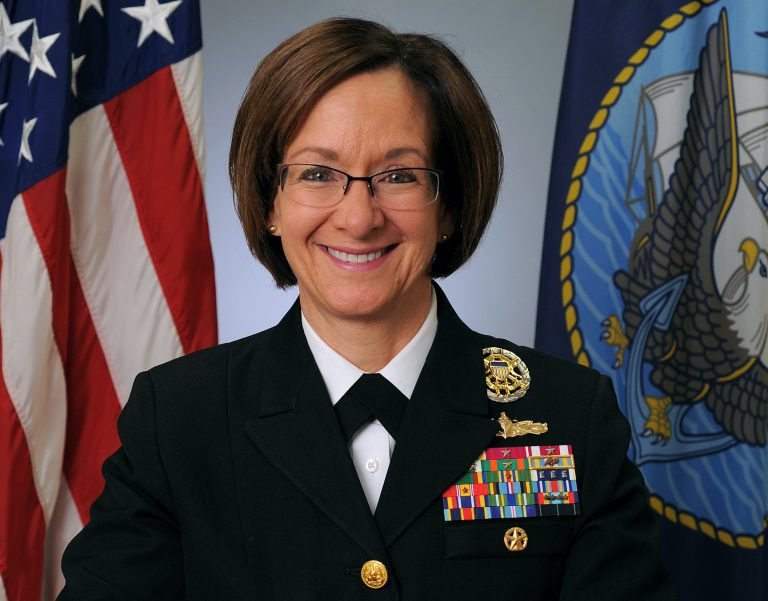Admiral Lisa Franchetti Becomes First Woman to Lead US Navy
In a significant milestone for gender equality and women’s representation in the armed forces, Admiral Lisa Franchetti has shattered the glass ceiling by becoming the first woman to lead the United States Navy. The historic appointment marks a momentous occasion and sets a remarkable example for aspiring individuals, particularly women, seeking careers in the defense sector. Let’s delve into the details of this noteworthy news and its implications for students preparing for government exams, including teachers, police officers, banking professionals, railway jobs, defense positions, and civil service roles like PSCS to IAS.

Why this News is Important:
Historic Moment in Gender Equality:
The appointment of Admiral Lisa Franchetti as the first woman to lead the US Navy is a historic moment in the journey towards gender equality. This achievement showcases that women can excel in leadership roles within the traditionally male-dominated defense sector.
Inspiration for Aspirants:
Admiral Franchetti’s ascent to such a high-ranking position serves as an inspiration for students preparing for government exams, particularly those eyeing careers in the military and civil services. It reinforces the message that hard work, dedication, and merit know no gender boundaries.
Historical Context:
The news of Admiral Lisa Franchetti’s appointment builds upon a legacy of women’s progress in the armed forces. Over the past few decades, women have gradually been breaking barriers and making their mark in the military, proving their mettle in various roles.
The journey towards gender equality in the US Navy began with the Women’s Armed Services Integration Act of 1948, which paved the way for the integration of women into the military on a permanent basis. Since then, the representation of women in the armed forces has steadily increased, and they have served with distinction in diverse capacities.
In recent years, various countries have witnessed women ascending to high-ranking positions in their respective navies, armies, and air forces. These milestones have been crucial in challenging gender norms and perceptions about women’s suitability for combat and leadership roles.
Amidst this backdrop, Admiral Lisa Franchetti’s appointment as the first woman to lead the US Navy stands as a momentous event, signifying progress and fostering a more inclusive and diverse military leadership.
Key Takeaways from “Admiral Lisa Franchetti Becomes First Woman to Lead US Navy”:
| Serial Number | Key Takeaway |
|---|---|
| 1. | Admiral Lisa Franchetti is the first woman to head the US Navy. |
| 2. | This appointment represents a significant milestone for gender equality and diversity in the defense sector. |
| 3. | Students preparing for government exams should be aware of her achievements and contributions throughout her military career. |
| 4. | This news underscores the importance of promoting inclusivity and breaking gender barriers in traditionally male-dominated fields. |
| 5. | Aspirants should understand the historical context of women’s progress in the armed forces to appreciate the significance of this appointment. |
Important FAQs for Students from this News
Q: Who is Admiral Lisa Franchetti, and what is her recent achievement?
A: Admiral Lisa Franchetti is a distinguished military personnel who has become the first woman to lead the United States Navy.
Q: When was Admiral Lisa Franchetti appointed as the Chief of Naval Operations?
A: The exact date of Admiral Lisa Franchetti’s appointment as the Chief of Naval Operations is not mentioned in the news article.
Q: What is the significance of Admiral Franchetti’s appointment for government exam aspirants?
A: Admiral Franchetti’s appointment serves as an inspiring example for students preparing for government exams, showcasing the potential for women to excel in leadership roles in the defense sector.
Q: What is the historical context of women’s representation in the US Navy?
A: The historical context traces back to the Women’s Armed Services Integration Act of 1948, which paved the way for the integration of women into the military on a permanent basis.
Q: What challenges do women still face in the defense sector despite this milestone?
A: Despite Admiral Franchetti’s appointment, gender disparities and biases still persist in the defense sector, limiting the representation of women in higher-ranking military positions.
Some Important Current Affairs Links


















